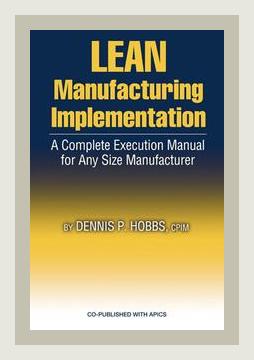Operations and Supply Chain ManagementInventory ManagementLean Manufacturing
Introduction
Dennis P. Hobbs’ book “Lean Manufacturing Implementation: A Complete Execution Manual for Any Size Manufacturer” is a comprehensive guide aimed at helping companies of any size to deploy lean manufacturing principles effectively. Lean manufacturing focuses on minimizing waste without sacrificing productivity. The book is grounded in practical strategies and a meticulous step-by-step approach that guides organizations through the lean implementation process. Below is a detailed summary, structured to capture the essence of the book, enriched with concrete examples and actionable advice.
Chapter 1: Overview of Lean Manufacturing
Major Points:
- Definition and Objectives of Lean Manufacturing:
- Lean manufacturing aims at eliminating waste, improving quality, and providing faster customer response times.
- Principles of Lean:
- Value, Value Stream, Flow, Pull, and Perfection are the core principles.
Concrete Examples:
– Value Mapping: Creating a value stream map to identify non-value-adding activities.
– 5S System: Implementing Sort, Set in order, Shine, Standardize, and Sustain to maintain an orderly workplace.
Actionable Advice:
– Conduct a Value Stream Mapping (VSM) Workshop: Organize a team meeting to identify and map all steps in the production process, distinguishing between value-added and non-value-added activities.
Chapter 2: Initiation and Planning
Major Points:
- Setting the Foundation:
- Importance of management commitment and setting clear objectives.
- Team Formation:
- Establishing cross-functional teams.
Concrete Examples:
– Leadership Workshops: Conducting workshops to gain top-management commitment.
– Team Charters: Drafting detailed charters for each cross-functional team, outlining roles and responsibilities.
Actionable Advice:
– Develop a Lean Manufacturing Charter: Create a document that outlines your lean initiative’s scope, objectives, key performance indicators (KPIs), and timelines, and obtain management buy-in.
Chapter 3: Lean Tools and Techniques
Major Points:
- Key Lean Tools:
- An introduction to tools such as Kaizen, Kanban, and Poka-Yoke.
- Application Framework:
- Detailed instructions on how to apply these tools within manufacturing settings.
Concrete Examples:
– Kanban System: Using visual signals to control the flow of materials in a just-in-time (JIT) production.
– Poka-Yoke: Implementing mistake-proofing devices to prevent defects.
Actionable Advice:
– Implement a Kanban System: Start by identifying bottleneck areas within your production. Design a visual Kanban board to streamline the movement of materials.
Chapter 4: Lean Implementation Strategy
Major Points:
- Phased Approach:
- Implementing lean in phases: Preparation, Pilot, Expansion, and Sustain.
- Metrics and KPIs:
- Emphasizing the importance of metrics to track progress and success.
Concrete Examples:
– Pilot Projects: Starting with a small-scale pilot project to test the feasibility of lean tools.
– Metric Dashboards: Creating visual dashboards to track performance against key metrics (e.g., cycle time, defect rates).
Actionable Advice:
– Run a Lean Pilot Program: Select a manageable area within your operation to begin the lean transformation. Measure outcomes and refine your strategies before a larger rollout.
Chapter 5: Overcoming Resistance to Change
Major Points:
- Understanding Barriers:
- Identifying common sources of resistance among employees and management.
- Change Management Techniques:
- Effective communication and training programs to foster a lean culture.
Concrete Examples:
– Feedback Loops: Creating regular feedback sessions where employees can voice concerns and suggestions.
– Incentive Programs: Introducing rewards for teams or individuals who successfully contribute to lean initiatives.
Actionable Advice:
– Establish a Lean Communication Plan: Develop a structured communication plan that includes frequent updates, success stories, and channels for employee feedback to build support for lean initiatives.
Chapter 6: Continuous Improvement and Sustainability
Major Points:
- Perpetual Refinement:
- Lean is a continuous journey and requires ongoing improvements.
- Sustainability Practices:
- Practices and cultural shifts necessary to sustain lean efforts.
Concrete Examples:
– Kaizen Events: Facilitating regular, structured events focused on incremental improvements.
– Standard Work Documentation: Regularly updating standard work procedures to reflect improvements.
Actionable Advice:
– Conduct Regular Kaizen Events: Schedule and execute weekly or monthly Kaizen events to continuously focus on small, incremental improvements.
Chapter 7: Case Studies
Major Points:
- Success Stories:
- Real-world examples of companies that successfully implemented lean manufacturing.
- Lessons Learned:
- Common themes and lessons from the case studies beneficial for new adopters.
Concrete Examples:
– SME Implementation: A small manufacturer reducing setup times by 50% using SMED (Single-Minute Exchange of Die).
– Large Enterprise: A major automotive supplier improving on-time delivery from 85% to 98% by integrating JIT principles.
Actionable Advice:
– Benchmark with Leaders: Study the case studies of successful lean implementations similar to your industry or scale. Identify best practices and adapt them to your context.
Chapter 8: The Role of Technology
Major Points:
- Leveraging Modern Tools:
- Using ERP systems and other software solutions to support lean efforts.
- Automation and Data Analytics:
- The importance of data-driven decision-making in lean environments.
Concrete Examples:
– ERP Integration: Implementing an ERP system to streamline inventory management and production scheduling.
– Data Analytics: Using data analytics to identify waste and optimize production processes.
Actionable Advice:
– Invest in Data Analytics Tools: Utilize data analytics software to gather and analyze production data, enabling informed decision-making and continual improvement.
Conclusion
Major Points:
- Summary:
- Lean manufacturing as a versatile and impactful approach for better efficiency and competitiveness.
- Future Outlook:
- The ongoing evolution of lean and the importance of staying updated with new methodologies and technologies.
Concrete Examples:
– Continual Education: Keeping abreast with the latest in lean methodologies through workshops, certifications, and ongoing training programs.
Actionable Advice:
– Commit to Ongoing Learning: Encourage management and employees to engage in continuous education and training in lean principles to stay current with advancements and maintain a competitive edge.
By following the structured guidance and real-world examples provided by Dennis P. Hobbs, manufacturers can successfully execute lean principles regardless of their size. This book serves as a valuable resource, offering actionable advice at every step to ensure a smooth and effective lean implementation.
Operations and Supply Chain ManagementInventory ManagementLean Manufacturing
